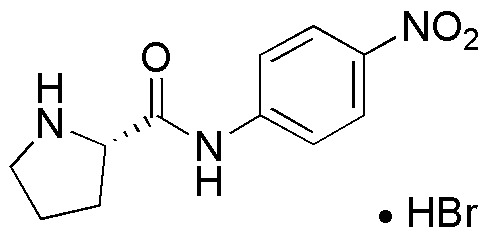L-Proline 4-nitroanilide hydrobromide is widely utilized in research focused on:
- Protein Synthesis: This compound serves as a useful reagent in the synthesis of peptides and proteins, aiding researchers in studying protein structure and function.
- Enzyme Activity Studies: It is employed in assays to evaluate enzyme activity, particularly in the context of proteases, providing insights into biochemical pathways.
- Drug Development: The compound is explored in pharmaceutical research for its potential as a lead compound in the development of new therapeutic agents, particularly in targeting specific biological pathways.
- Analytical Chemistry: It is used in chromatography and spectrometry for the analysis of amino acids and peptides, enhancing accuracy in quantitative assessments.
- Biochemical Research: The compound plays a role in studying metabolic processes, contributing to a better understanding of cellular functions and disease mechanisms.
General Information
Properties
Safety and Regulations
Applications
L-Proline 4-nitroanilide hydrobromide is widely utilized in research focused on:
- Protein Synthesis: This compound serves as a useful reagent in the synthesis of peptides and proteins, aiding researchers in studying protein structure and function.
- Enzyme Activity Studies: It is employed in assays to evaluate enzyme activity, particularly in the context of proteases, providing insights into biochemical pathways.
- Drug Development: The compound is explored in pharmaceutical research for its potential as a lead compound in the development of new therapeutic agents, particularly in targeting specific biological pathways.
- Analytical Chemistry: It is used in chromatography and spectrometry for the analysis of amino acids and peptides, enhancing accuracy in quantitative assessments.
- Biochemical Research: The compound plays a role in studying metabolic processes, contributing to a better understanding of cellular functions and disease mechanisms.
Documents
Safety Data Sheets (SDS)
The SDS provides comprehensive safety information on handling, storage, and disposal of the product.
Product Specification (PS)
The PS provides a comprehensive breakdown of the product’s properties, including chemical composition, physical state, purity, and storage requirements. It also details acceptable quality ranges and the product's intended applications.
Certificates of Analysis (COA)
Search for Certificates of Analysis (COA) by entering the products Lot Number. Lot and Batch Numbers can be found on a product’s label following the words ‘Lot’ or ‘Batch’.
*Catalog Number
*Lot Number
Certificates Of Origin (COO)
This COO confirms the country where the product was manufactured, and also details the materials and components used in it and whether it is derived from natural, synthetic, or other specific sources. This certificate may be required for customs, trade, and regulatory compliance.
*Catalog Number
*Lot Number
Safety Data Sheets (SDS)
The SDS provides comprehensive safety information on handling, storage, and disposal of the product.
DownloadProduct Specification (PS)
The PS provides a comprehensive breakdown of the product’s properties, including chemical composition, physical state, purity, and storage requirements. It also details acceptable quality ranges and the product's intended applications.
DownloadCertificates of Analysis (COA)
Search for Certificates of Analysis (COA) by entering the products Lot Number. Lot and Batch Numbers can be found on a product’s label following the words ‘Lot’ or ‘Batch’.
*Catalog Number
*Lot Number
Certificates Of Origin (COO)
This COO confirms the country where the product was manufactured, and also details the materials and components used in it and whether it is derived from natural, synthetic, or other specific sources. This certificate may be required for customs, trade, and regulatory compliance.


